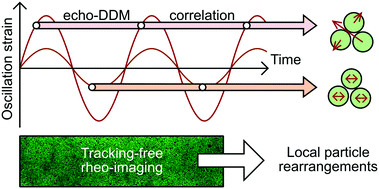Characterising shear-induced dynamics in flowing complex fluids using differential dynamic microscopy†
Abstract
Microscopic dynamics reveal the origin of the bulk rheological response in complex fluids. In model systems particle motion can be tracked, but for industrially relevant samples this is often impossible. Here we adapt differential dynamic microscopy (DDM) to study flowing highly-concentrated samples without particle resolution. By combining an investigation of oscillatory flow, using a novel “echo-DDM” analysis, and steady shear, through flow-DDM, we characterise the yielding of a silicone oil emulsion on both the microscopic and bulk level. Through measuring the rate of shear-induced droplet rearrangements and the flow velocity, the transition from a solid-like to liquid-like state is shown to occur in two steps: with droplet mobilisation marking the limit of linear visco-elasticity, followed by the development of shear localisation and macroscopic yielding. Using this suite of techniques, such insight could be developed for a wide variety of challenging complex fluids.



 Please wait while we load your content...
Please wait while we load your content...